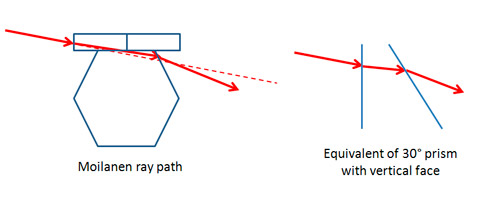
I would like to present a possible explanation for the Moilanen arc. I have read about the existence of this unexplained arc a few weeks ago and tried to figure out possible explanations. After getting the reflected lower sunvex parry and some pyramidal arcs that were also looking like the Moilanen arc, I think I finally have a crystal that makes a very good candidate for the explanation of Moilanen arc.
Responsible crystal
The responsible crystal would be a crystal made of a two hexagonal usual hexagonal crystals stuck together. The simplest configuration would be the one of a plate crystal (called the main plate) with another plate or a column stuck on one of its base (called the stuck crystal).
Figure 1.
Condition of creation of Moilanen arc
The conditions for the creation of a Moilanen arc from this configuration are the following:
1: The main plate must be horizontal
2: The stuck crystal is on the inferior base of the plate
3: The bases of the stuck crystal must be perpendicular to two side faces of the main plate
1 and 2: this configuration is aerodynamically stable when stuck crystal is centered on the inferior base plate. To figure this, one can think of a paratrooper, the parachute being the plate crystal and stuck plate or column being the charge. So naturally the main plate will rotate so the stuck crystal is on the inferior base. Now why would the stuck crystal be centered on the main plate? I think that for this stuck crystal configuration to happen, the crystal density must be very high. So in the case of crystal swarms created by snow machine, the crystals would be stuck when they are small, just after their creation. So the growth of the crystal, will happen after. The growth being isotropic, the stuck crystal will naturally be centered on the main crystal. And the aerodynamically stable condition is the main plate being horizontal with stuck crystal on the inferior base.
3: I have to admit that the perpendicularity of the bases of the stuck crystal and two sides of the main plate is the most challenging point. My best explanation on this is that as the two components are crystals, there are definitely orientations of stucking that will be more stable. I hope that crystal experts will be able to help on this point to validate that this orientation is more likely to happen than any other. Crystal samples obtained during the display of 14th of December 2009 by Mika Aho, Ágnes Kiricsi and Marko Riikonen show some crystal looking very much alike the one described in the proposed explanation
Figure 2 and 3.
Ray path responsible of Moilanen arc
The ray path responsible of the Moilanen arc is the rays entering a vertical side face of the main plate and exiting the upper lateral side face of the stuck crystal. The prism angle in this configuration is 30° but with the entrance face vertical.
Figure 4.
Usually associated halos
This configuration of crystal is so still capable of producing all the plate arcs (parhelia, parhelic circle, circumzenithal arc, pillars, etc…) and also the Parry arcs (sunvex through the stuck crystal and suncave through the upper base of the plate and the stuck crystal. So this configuration seems to be well compatible with the halos usually observed with the Moilanen arc.
Spurious arcs
I have been able to check it thoroughly but there does not seem to be any spurious arcs from this configuration. Spurious arcs would be created by rays entering side faces of the main plate and side faces of the stuck crystal. I will try to check it, but for the most simple other rays, it does not seem to exist direct ray path, at least if the stuck crystal is a regular hexagonal crystal.
Other rays would just create already known halos. Rays entering by the base of main plate and exiting by the sides of stuck crystal would create parry arcs, and by the base of main plate and exiting by the base of stuck crystal would create circumzenithal and supralateral arcs.
Distance from the sun
The distance between the apex of the Moilanen arc and the sun can be easily calculated using the 30° prism with vertical entrance face description. At low sun elevation, the distance is about 11°. It increases slowly to 13° at 10° solar elevation, 15° at 15° solar elevation, 18° at 20° solar elevation. As the sun elevation increases, the rays path becomes less likely because of the stucking area and also of the increased incidence on the exit face. The total internal reflection condition is met when the solar elevation is higher than 26°. This is in agreement with the fact that Moilanen arc are usually observed at low sun elevations.
Figure 5.
Shape evolution
I have made a simple ray tracing program to simulate the Moilanen arc shape. This simulation tool does not take into account the real crystal shape, only the relative orientation of the faces. The shape are represented for 0°, 3°, 6°, 9°, 12°, 15° and 18° solar elevation. The simulated shape matches very well the photographs of the arc, with a reduced curvature at higher solar elevation. The simulation shows the arc being more extended on the sides as I don’t take into account the real 3D shape of the crystal, but just the relative face orientation.
Figures 6, 7, 8.
Conclusion
The proposed explanation is based on a 30° prism which entrance face is vertical. In this explanation, the responsible is a horizontal plate on which is stuck a plate or column crystal. I think this type of crystal explains very well most (if not all) of the observed properties of Moilanen arc. More simulations to check that no spurious arcs arc created would help confirm this, as well as some insights of crystals experts on the probability of getting such configuration.
Nicolas Lefaudeux, January 29th 2010

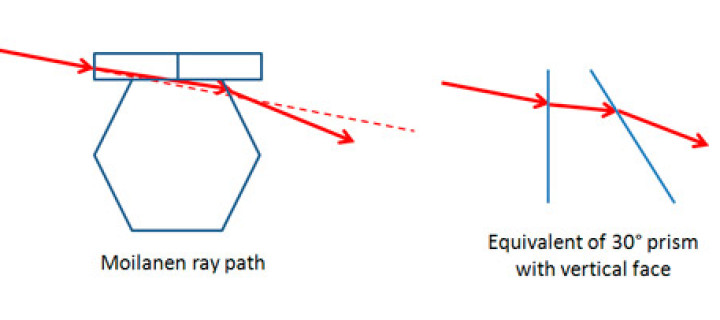
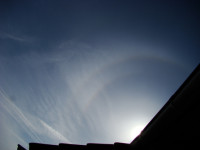
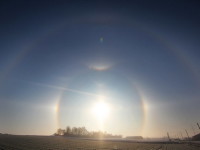
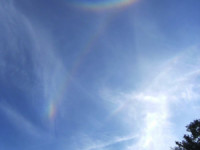
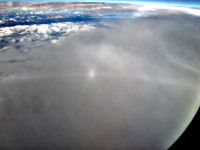
I hope this will be the explanation for this arc. Its driving me crazy we have had tons of displays with this arc whether its weak or sharp and bright and still nothing out of the ordinary shows in the crystal samples except crossed plates. Who ever can find the mystery behind M-arc should get a big reward.
Thanks a lot, Nicolas, for sharing these ideas! I found your writing very thought provoking, indeed. The guys here are way better at Physics than I am, so I’m really looking forward their comments. All I can add is that besides Marko’s 14 December crystal photos, it is worth having another look at his 2007-2008 Rovaniemi samples, showing stages both with and without Moilanen arc. To my eyes, there are actually quite many crystals resembling the ones suggested by you. I’m very interested in what our experts will say.
unfortunately, I don’t see lots of crystal looking like the ones described in the 2007-2008 Rovaniemi samples. maybe the combination of crystals have been broken as the density of crystals in the sample is much higher as in 14 december 2009 samples?
about the conditions described (horizontality of the main plate and relative orientation of the stuck crystal) for creation of Moilanen arc, it appears that if the main plate is not perfectly horizontal or if the stuck crystal has a different orientation on the main plate, it is still possible for Moilanen arc to form. sensitivity on these conditions seems to increase with solar elevation which can be interpreted as being consistent with the Moilanen arc being less defined at high solar elevation…
I will conduct few more simulations about this next week
Best
Nicolas
It is good to have fresh views. This 30 degrees angle – I don’t know in which crystal arrangement – has been probably considered by Moilanen, I think. Here I see that this crystal would probably make also lower Moilanen, which does not seem to exist. It also looks like this arrangment would make weak Moilanen when light source is near horizon. When light source gets below horizon the ray path reverses. I have photo of Moilanen with -12 degree elevation spotlight.
Anyway, I have put more Moilanen arc display crystal photos for download, if anybody is interested. These are from the Himos display last winter, some of you guys already have these zip-packets. These crystal fell on the dish about the time when this photo by Jari Luomanen was taken. Considering the intensity of the Moilanen arc, I would see that in each photo there should be plenty of Moilanen arc crystals.
Well. This crystal is some kind of a new idea, but similar ray path has been studied earlier at least by me. Crossed plates can also have similar ray paths.
Sorry to say, but this ray path does not work. There is a major problem with it: Marko Mikkilä has photographed a clear Moilanen arc at moon elevation of 26.2 degree. The arc was about 15.4 degree above the moon. That does not fit distances we get from this ray path. So vertical entry face does not work. Entry face have to be inclined. It also seems that simple 30 degree prism angle is not working.
I do not know if this crystal is plausible as a halo making crystal. You may find some similar crystals in a crystal samples, but is it so common crystal form that you can get a visible halo from it?
But, this was a good try! I like to hear more ideas!
Here are some crystals from a display with a weak Moilanen. The gallery has larger shots as well. I think these long thin crossed plates might have the answer.
yes this observation of a Moilanen arc at 26degrees elevation invalidates this model 🙁
do you have a link to this photograph?
in the crossed plates model, what is the angle of crossing? it is true that crossed plates crystal offer a very large area for creating Moilanen arc
i have absolutely no idea on how common such crystals may be. in fig3, there are 3 out of ten crystals like the one describe, but i found nowhere else such an impressive ratio
http://markom.kuvat.fi/kuvat/Halo%20Photos/DSC_0082.jpg
Jarmo is this the photo what you mentioned? Im not sure… This photo is stack of 5 photos, heavily modified.
extremely interesting picture! it even seems to be two Moilanen arcs, the main one around 15degrees and the other around 10degrees from the sun
it definitely shows that the proposed explanation is not the good one. i think i’ll keep thinking of the Moilanen arc for a while!
Nicolas
Yes, that is one of those photos. I think I used one not stacked photo for measurements. I think somebody should check if he/she gets the same result for lunar height and distance for the arc.
Yes Nicolas. There seems to be some kind of halo like brightening about 11 degree above the moon. I am not sure what we see in these photos. Both those arcs could be from similar ray paths but from different orientation.
By the way, that lower stuff has missed totally our attention.
Any good ideas are welcome!
in the configuration of a prism with a vertical face, there is also the configuration of vertical exit face (in the proposed crystal, it would be stuck crystal on the upper face of main plate) which is very close to minimum deviation condition and gives an arc similar to Moilanen but located at a distance of sun which remains very constant (around 10degrees) for a range of solar elevation from 0 to 30+ degrees…
If i remember correctly we agreed that lower “stuff” was only jpg artefact.
I’m not sure about the artefact explanation. How does it look when you usm it in the original 16-bit depth?
I will make some new stacks with different variations…
Here is some new variations… 16bitt version stacked 7photos, and inverted version from the same photo.
http://markom.kuvat.fi/kuvat/Halo%20Photos/7stack900x600+inverted.tif
http://markom.kuvat.fi/kuvat/Halo+Photos/7stack900x600.tif
Interesting post. It is good to know there are people out there trying to figure out the Moilanen arc mystery. Apparently we need to keep searching.
I agree with Jukka, this is very nice. One of these days someone finally cracks it.
Is it necessary that the stuck crystal hang down from the main crystal like a paratrooper? What happens to the simulation if the crystal orientation is random? If the stuck crystal and the main crystal are equal sizes or the stuck crystal is bigger the stuck crystal might try to float horizontal, and the assembly would tumble a lot.
If the orientation is random, then you get a circular halo of 11 degrees with this 30 degrees refracting angle. It is interesting that we have not observed such halo in Moilanen arc displays. But it should make it easier to narrow our search for the crystal – we should be looking for crystals that look like they orient pretty stably.
yes, exactly i think we have to find a crystal that match the Moilanen arc for its “zero” orientation. basically, tumbling will just make the Moilanen arc fuzzier. as there are many pictures on which the arc is sharp, tumbling does not look like being able to help.
What if the Lefaudeux crystals are floating upside down, so the light goes into the angled face first? Granted that is a less stable configuration, but perhaps it could still happen, if the stuck crystal is small enough.